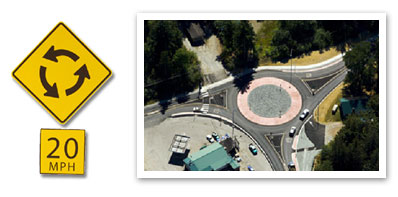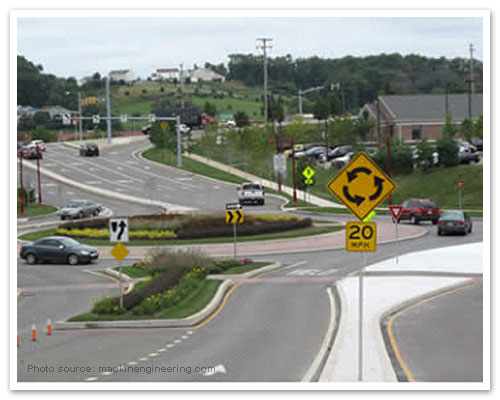How to Drive in a Roundabout
Roundabouts, also called traffic circles or rotaries, eliminate the most dangerous kinds of collisions that occur at four-way intersections: right-angle, left-turn collisions and head-on collisions. Plus, when used correctly, roundabouts reduce traffic delays by keeping traffic flowing smoothly. A roundabout is an intersection where traffic travels around a central island in a circular, counter-clockwise direction.
 Single Lane Roundabout
Single Lane Roundabout
While roundabouts may seem confusing at first, they are much safer than regular intersections. In fact, roundabouts reduce traffic fatalities by 90%. They reduce injuries in collisions by 75%, they reduce pedestrian crashes by 40%, and they reduce all collisions by 37%.
One reason roundabouts are safer is that they make head-on, high-speed collisions almost impossible since all vehicles are traveling in the same direction. Head-on collisions are extremely dangerous and often deadly. Another reason that traffic circles are safer than traditional intersections is because they reduce speed. All vehicles must slow down before entering a traffic circle, so there’s no chance of a vehicle running a yellow or red light and slamming into an oncoming vehicle.
Other advantages of roundabouts include reduced traffic congestion and reduced pollution and fuel use because there are fewer stops and hard accelerations. Roundabouts also cost less to build since there is no signal equipment to install or maintain and less pavement to lay down.
Check out the video below to learn how to drive in a roundabout.
Tips for Driving in a Roundabout
Using a roundabout is pretty straightforward: when you enter the roundabout, you must yield the right-of-way to drivers who are already in the roundabout. If the roundabout has more than one lane, move to the outer lane before exiting and always use your turn signal. Keep a close eye out for pedestrians and cyclists.
Here are some things to keep in mind when driving in a roundabout:
- As you approach a roundabout, make sure you know which exit you need to take ahead of time. The roundabout will have signs to help you know which lane to be in.
- Yield the right-of-way to traffic already in the roundabout. Be sure to look for pedestrians that are crossing the street in the roundabout.
- When you see an open gap, enter the roundabout cautiously. The speed limits are usually 15 or 20 miles per hour.
- Once in the roundabout, do not stop unless there’s an emergency. Roundabouts are designed to keep traffic flowing smoothly, so if you stop in a roundabout, you will most likely cause a collision.
- Follow the signs or pavement markings to take your desired exit.
- When it’s time to exit the roundabout, don’t forget to use your turn signal and exit to the right. Left turns are completed by circling the center island and then making a right turn to exit.
- If you miss your exit, just keep moving. One nice thing about roundabouts is their circular shape: if you get confused, you can just try again on your next rotation.
If an emergency vehicle approaches while you are in the roundabout, drivers should behave in the manner as they would on any other road: carefully move as far right as possible and, if necessary, stop until the emergency vehicle passes.
 Roundabout
Roundabout
Take an Online Course to Learn More
If you enjoyed this article and are interested in learning more about driving-related topics, you should check out our courses on www.safe2drive.com.
We offer courses in a variety of topics including Defensive Driving and Driver Education. In addition to teaching you how to be a safe driver, our courses can help you dismiss a ticket, get your driver license, or even get an insurance discount. We also have courses specifically tailored to mature drivers (i.e., drivers age 55 and older) for insurance discounts.